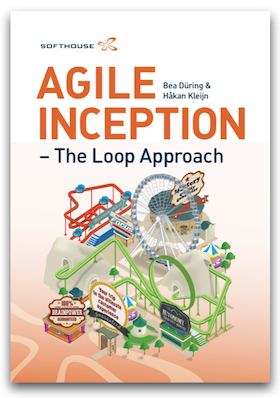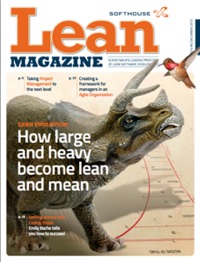Lean & Agile management needs a new breed of managers focused on spawning motivation, supporting team-based work and understanding systems. Here, Esther Derby discusses her views on Lean & Agile management with Kristoffer Nordström of Softhouse.
In your view which are the most desired characteristics and behaviors for good Lean & Agile managers?
Managers in any context need to enjoy working with people, or be willing to learn to work with people. Many managers have faulty ideas about motivation. Many of these ideas are based on the assumption that people are lazy and won’t work hard unless they are enticed or threatened. Managers need to understand what really motivates people and how to shape their organizations to harness intrinsic motivation.
On one hand, they need to be wellversed in team dynamics, and how to structure the organization to support team-based work. On the other hand, they also need to be able to understand and work with systems. That’s a skill that’s largely neglected in business schools, management training, and the popular management literature.When managers don’t have these skills, they rely on telling, selling, and yelling.
What are the most common mistakes made by management in your view when implementing Lean & Agile?
Thinking that fixing the development process will fix organizational problems. No method can solve problems unless managers also change.
There are different types of managers in a typical development organization. Could you very simply describe the major changes for these roles when you go from traditional management to management in a Lean & Agile valuebased organization?
We have Project Managers, Product managers, Line Managers and Top level Management.There is no simple answer. The answer depends on the needs of the people and the work. What works for a company of 100 people with two software products won’t work for a company with 10,000 employees, companies with many products, or companies whose product involves hardware and software.
This is an area where we need to look outside our profession and find guidance from the research and practices of organizational design and organization development.
My colleagues and I notice a lot of confusion when we meet managers. They see a new behavior in their development teams when these have started to work according to Lean & Agile principles. Although the development teams are usually happy with the change, the managers often start to ask themselves questions. “What should I do now? How can I support this? How do I avoid destroying the good things?” What is your message to these confused managers?

Don’t tamper if things are working. Ask what is getting in the way, and go fix it. Ask what the team needs, and obtain it for them. Ask what you can do to help.If the team says “nothing”, don’t inflict help.
The truth is, when teams are working well, managers don’t need to intervene. The hard work is in establishing a real team and ensuring enabling conditions are in place. When managers of self-sufficient teams feel like they aren’t doing much, it’s a sign they’ve succeeded. But managers shouldn’t abandon the team. Teams need support and a connection to the organization.
Managers still have an important job to do, working at the system level. Collect metrics that will give a window into the system. Start by tracking the ratio of fixing work to featurework. Then, find out what is driving the fixing work, and start working to improve those issues.
Are there individual managers that will not fit into this ”new” management?
People who cannot manage themselves should not manage others. People who can only work through telling, selling, and yelling won’t be successful in companies that embrace Lean & Agile philosophies.
Some companies find they don’t need as many managers. Some people who are in management roles find they are happy to go back to technical work. But, to me the new roles for managers are exciting and full of promise-developing people, seeing and steering the system, creating environments where people can build products and services that delight customers, satisfy stakeholders, and empower employees.
Can everybody change their behavior or do we need to move some people? To where?
Not everyone is capable, and not every one will want to. Some of those people will leave of their own accord. If there is a place in the organization where people who can’t or don’t want to change can still be of service within the organization, support them to find it, and then let them be.
We can never be 100 % successful when we expect everyone to change. Don’t spend your precious energy trying to change people who don’t want to. Work with the people who want to change, and most often, when a critical mass has moved to a new way of working, most will come along.
If there are some people who are acting in a way that is destructive to people or the organization, help them find the door. (This advice applies whether you are using Lean, Agile or any other method known to man.)
We usually say that ”Measurements drive behavior”. What kind of measurements or KPIs do you see drive the ”right” management behavior in a Lean & Agile organization?
When managers are measured on meeting trickle down objectives, delivering fixed functionality by a fixed date, meeting fixed budgets, we will see the same behavior we’ve seen for decades. This is the story of local optimization that comes from Management by Objectives (MBO). MBO (and similar schemes) pit managers against each other, vying for scarce resources, and meeting their own goals at the expense of the organizational goals. To quote Deming,“If you give a manager a target, he will meet it, even if he has to destroy the organization to do so.” If you want the patterns to change, you need to change the structures that are holding the old patterns in place.
When managers are evaluated on improving the organization, that’s where they will focus attention.Rather than set improvement targets (which almost always lead to dysfunction) they should look for year over year improvements, and evaluate people on what they can control.
When making a Lean & Agile transition within an organization you start a journey that changes your employees’ ways of thinking that makes it impossible to turn back to “the old way of working”. How do you make sure management really understands the impact on the individuals in the organization and what this journey entails?
I’m not sure people can understand exactly what such a journey entails, unless they’ve been on a similar journey. It’s one of those things that must be experienced. You have to be open to learning along the way. It’s hard to imagine how enlivening, satisfying – even fun – work can be when you’ve been working in a soul-sucking organization. Sadly, many people don’t have first hand experience of anything else. They don’t know what it’s like to work where people are empowered to do good work, are treated like intelligent adults, and create products and services that delight their customers.
That said, it helps to have an accurate model of how people experience and respond to change. As much as we’d like to see immediate improvement, when organizations take on a big change, performance will be rocky for a while. When managers panic and pull back from the change, or try another option, they shock the system again. People need some time to learn and integrate any new method or process. They need to get their feet back under them before the next change.
It is essential to change the structures that hold the old patterns in place. For example, if your organization has used individual goals, make part of each person’s goal dependent on team success. Make it a big enough portion that it matters. This works on two levels. First, it signals that the change is real, not the sameold same-old with a new name. Second, it makes it more likely that the desired new pattern of behavior will emerge and stick.
Six tips from Esther Derby on how to get commitment from management in making the transition to Lean & Agile
- Make sure managers know they still have a part to play, and involve them in shaping what that part will be.
- Make sure you carry forward the good parts of the existing system.
- Consider the structures that will help the new patterns form.
- Adjust the structures that will hold the old patterns in place.
- Provide training, coaching, and support to help people in management roles learn a new way to work.
- Model the behavior you want to see from the top of the organization.
- Celebrate successes, acknowledge and learn from mistakes.
- Enjoy the journey.




